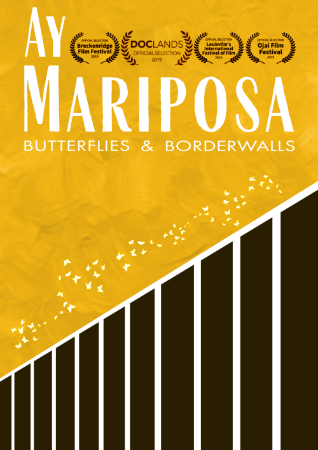
Ay Mariposa: Butterflies & Borderwalls 2019
Distributed by Collective Eye Films, 1315 SE 20th Ave. #3, Portland OR 97214; 971-236-2056
Produced by Krista Schlyer and Jenny Nichols
Directed by Krista Schlyer
Streaming, 57 mins
Middle School - General Adult
Activism; Environmentalism
Date Entered: 07/15/2020
Reviewed by Lauren Stieglitz, Science Liaison Librarian, University of AlbertaAy Mariposa is a moving film covering the threat the National Butterfly Centre faces from the US-Mexican border wall. The film presents three narratives intercut throughout the film: the perspective of Marianna Trevino Wright, the director of the National Butterfly Centre; Zulema Hernandez, an immigrant who narrates her life story; and a voiceover detailing the life cycle of butterflies.
This film weaves these three narratives together to mixed success. Marianna Trevino Wright presents a fascinating portrait of the environmental importance of the Centre, and details both the threat presented by the border wall and the steps she has taken to fight for the Centre. Zulema Hernandez narrates her life story over a series of recreated vignettes, exploring her young life, immigration to the United States as a farm worker, and her current activism. The final storyline is an overly personified and flowery narrative of the butterfly life cycle that highlights how precious the survival of butterflies can be. Each element of Ay Mariposa is beautifully filmed. The imagery of butterflies and the National Butterfly Centre is stunning. Additionally, the recreations of Zulema Hernandez’s life are beautifully shot and contribute greatly to the emotional impact of her narration.
The narrative structure interweaves each narrative in an interesting way, but it ultimately does not have the emotional impact that the filmmaker was clearly going for. These three sections represent significant changes in tone and levels of interest. The two women’s stories, though fascinating on their own, do not connect to each other in content or style enough to make a truly compelling film.
This narrative structure makes the film more appropriate for a general audience than an academic one. By focusing on three narratives, the documentary is unable to fully explore the ecological and human impacts the border wall has. Clips of Marianna Trevalo Wright and the National Butterfly Centre may be useful in an environmental studies class. As a whole, Ay Mariposa is compelling for a general audience who enjoys human stories, but it is not substantive enough to be very useful in a classroom.